The Best Antiperspirants for Persistently Sweaty Pits
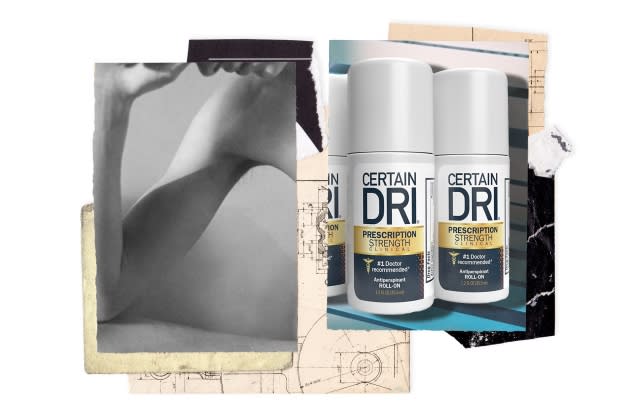
Our editors independently select the products we recommend. We may earn a commission on items bought through our links.
The one thing many men know about antiperspirants is that they cause cancer. The thing is that they don’t. Or at least no one has proved that they do. Scientists and doctors have repeatedly failed for multiple decades to prove that there’s correlation between the use of antiperspirants in deodorant and cancer. Many studies indicate zero connection. While this may award a sigh of relief to anyone haunted by hyperhidrosis, a condition that causes excessive sweating not related to heat or exercise, or even periodic pit perspiration, the persistent question of safety lingers like a pit stain.
Today's Top Deals
Antiperspirants work by sending aluminum salts into the pores, where they dissolve and effectively clog the pores for an extended period of time. Different brands use different aluminum compounds as active ingredients. The most common compounds are aluminum chlorohydrate (usually found in liquid roll-ons and sprays) and aluminum zirconium tetrachlorohydrex (usually found in solid applications). And not all antiperspirants are deodorants though many brands produce combination product. Deodorants mask odors or restrict odor-producing bacteria. Antiperspirants reduce sweating.
In effect, antiperspirant consumers have to decide what quantity of aluminum salts they are comfortable with. The trade-off is between perceived long-term risk and immediate comfort. Some consumers chase “natural” deodorants – many of which work poorly or not at all – others buy undershirts. Ultimately, it’s a personal decision, but the data tells a story: Antiperspirants work.
What the Experts Say
Dr. Sherly Soleiman, MD, founder and board-certified physician at Cosmetic Injectables Center in Los Angeles explained that there are actually 18 different types of aluminum ingredients found on the bottles of antiperspirants. The FDA only regulates the maximum amount allowed in over-the-counter antiperspirants for each active aluminum ingredient (between 15-25% maximums between all 18). “Each ingredient has its own benefits—some being better utilized in a liquid versus a solid, versus roll-on, versus spray,” she adds.
This variance in ingredients and strengths makes it near impossible to gauge which product at your local Walgreens and Duane Reade will be most effective for you based on the concentration of an active ingredient, and near-impossible unless you read O-chem textbooks in your free time. What, aluminum sesquichlorohydrex propylene glycol and aluminum zirconium tetrachlorohydrate don’t mean anything to you?
The exception will be for anything labeled “clinical grade”, which in any OTC product will err on the maximum end of each ingredient’s FDA regulation, and will most likely be aluminum chloride (but not always). Similarly, for sensitive skin, there’s a good chance that the products marketed here will deploy aluminum sesquichlorohydrate (but, not always).
Don’t overthink this. Let the FDA be your safeguard against buying a sham product. They regulate how these products can be advertised (almost like how SPF has specific FDA rules for things like protection level and water resistance). So, if the antiperspirant product reduces moisture in the area by up to 20% for 24 or 48 hours, then it can be labeled with the respective benchmark.
We’re even starting to see some 72- and 96-hour products (offering that same minimum-20% reduction for the duration of the claims)—and these are in OTC options like those from Degree and Dove below. Anything offering 30% reduction can also be labeled “extra effective”.
Regarding cancer risks for toxicity concerns, the risk is quite low, says Soleiman, even in those high, prescription-grade doses.
“People in the highest risk group are those in jobs exposing them to long-term inhalation, like welding, or those who receive long-term aluminum injections—like aluminum-containing allergy shots weekly or monthly over many years,” says Soleiman. “Topical and oral exposure to aluminum has less absorption [and thus less risk for toxicity].”
Still, Soleiman advises keeping topical levels to the minimum amount needed. Only “level-up” from the OTC options if it is proving ineffective at stopping the problem. At this point, though, it’s important to see a dermatologist to discuss the best path forward, be it a clinical-grade pick or a prescription-level remedy.
To get the best results from an antiperspirant, you should apply the product to your underarms before bed, says Dr. Robert Finney, board-certified cosmetic dermatologist at Entière Dermatology. “This way it can absorb into the sweat duct and dry so that it stays there. If it is applied hastily in the morning then we go about our day, it is unlikely to get a chance to fully dry and we will likely start to perspire which will inhibit the anti-perspirant from ever preventing sweat production.”
You can also “train” your body to prolong the efficacy of some higher-grade antiperspirant products, notes Finney. He is a success story in this way: “I began using [high-grade] Certain Dri Roll-On 20 years ago, and when I first started, I used the product several times a week,” he says. “After a month or so when I got better control of the sweat, I was able to reduce the frequency. Currently, I only need to do it once a week and have complete control of my underarm sweating.”
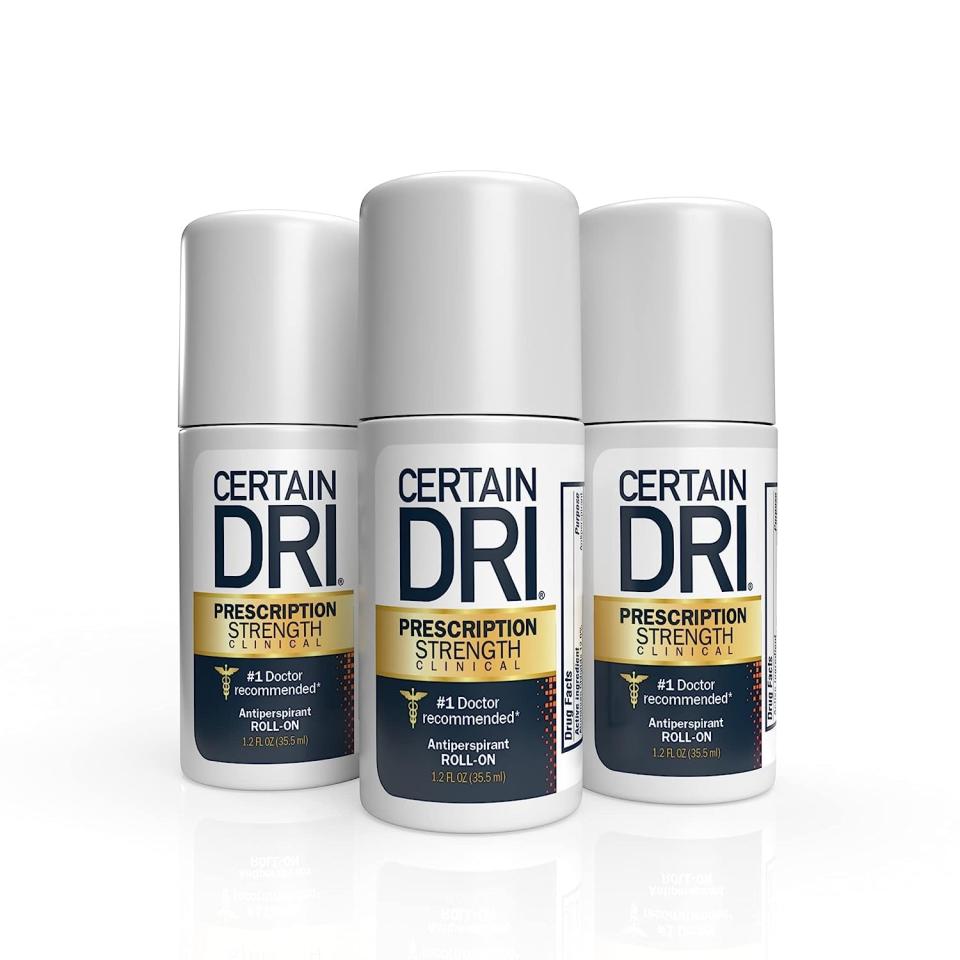
EXPERT PICK
Certain Dry Prescription Strength Antiperspirant
Buy Now On Amazon
Buy Now at walmart
Buy Now at Target
“I always recommend an anti-perspirant with [at least] 12% aluminum chloride,” says Finney. (Certain Dri Prescription Strength Clinical roll-on has 12% and Duradry PM gel has 15%.) “They are both the most effective OTC options. The one drawback can be irritation, so I tell people to start off slowly and to moisturize the areas on the nights when not using the product. Slowly titrate use until the desired result has been achieved.”
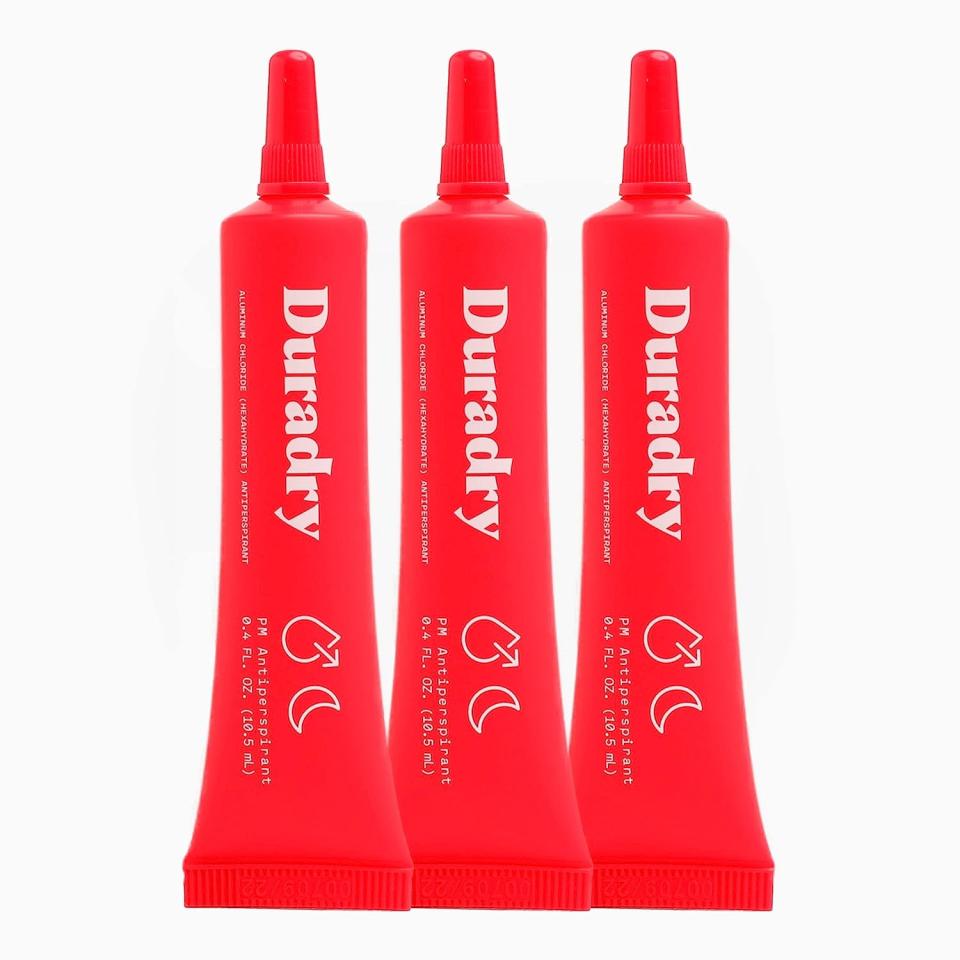
EXPERT PICK
Duradry PM Antiperspirant Gel
Buy Now On Amazon
With Duradry—a superior option on this roster for hyperhidrosis—apply a pea-sized amount every night for 24-hour protection at the start; results may extend beyond that once things adjust. For both products, make sure to apply to clean, completely dry skin.
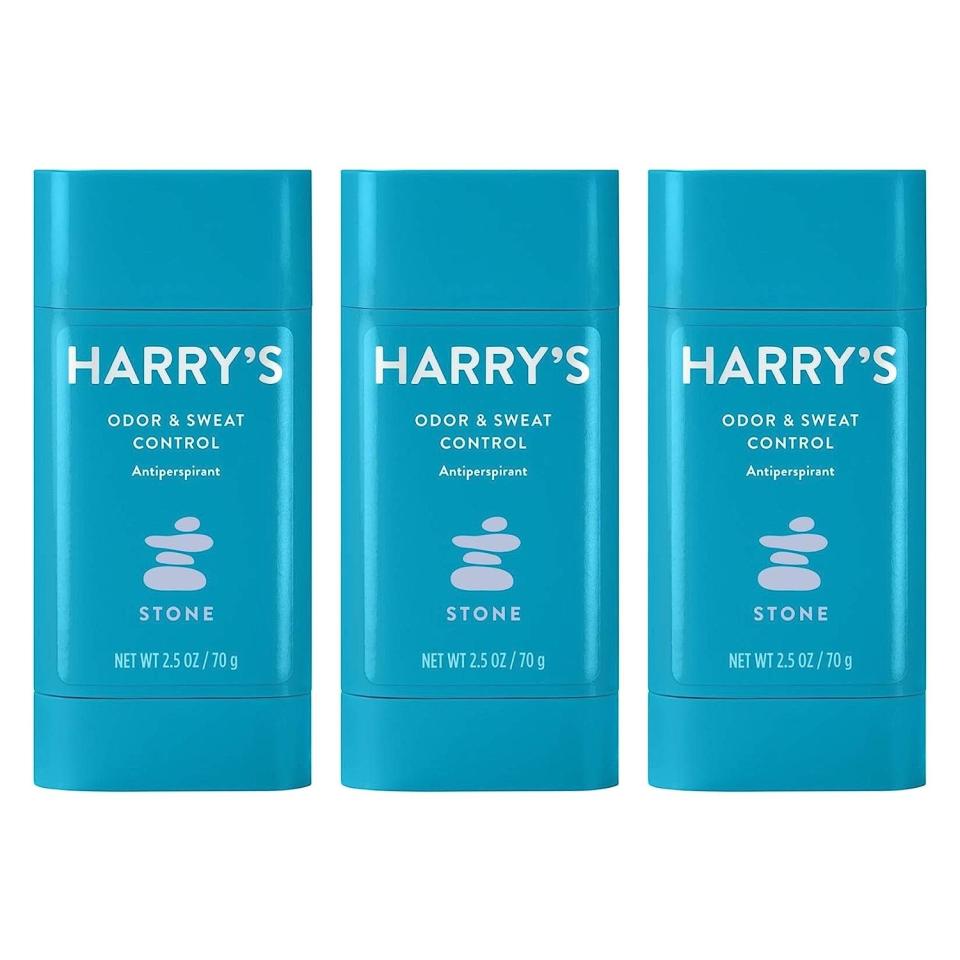
BEST FOR MOST PEOPLE
Harry's Antiperspirant Deodorant
Buy Now On Amazon
Key Ingredient: Aluminum zirconium tetrachlorohydrex GLY (16%)
How It Works: Harry’s has a nice trio of underarm options for each degree of need, and this one sits squarely in the middle as the most level defense against moisture and odor alike. The recipe centers on a high-performing heap of aluminum zirconium tetrachlorohydrex, but a lower dose than someone with hyperhidrosis may require. This antiperspirant deodorant is as middle of the road as it gets—in the best way possible—plus comes in four equally delicious scents. (Go with Stone or Shiso…)
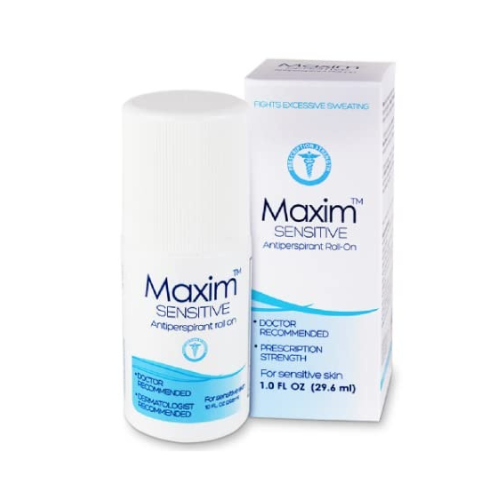
BEST FOR SENSITIVE SKIN
Maxim Sensitive Clinical Strength Antiperspirant
Buy Now On Amazon
Key Ingredient: Aluminum chloride (10.8%)
How It Works: Let’s say you experience excessive sweat and sensitivity issues; that can be a problem since you need high-performing chemicals on your oh-so-intolerant skin. Maxim Sensitive Clinical Strength turns up the dose on standard-fare aluminum chloride, but not so much that it irritates your pits. If you shave or wax your pits regularly, a practice that may increase irritation, this is another great option. (Just don’t apply it immediately after either step. Wash the skin and let it recover first.)
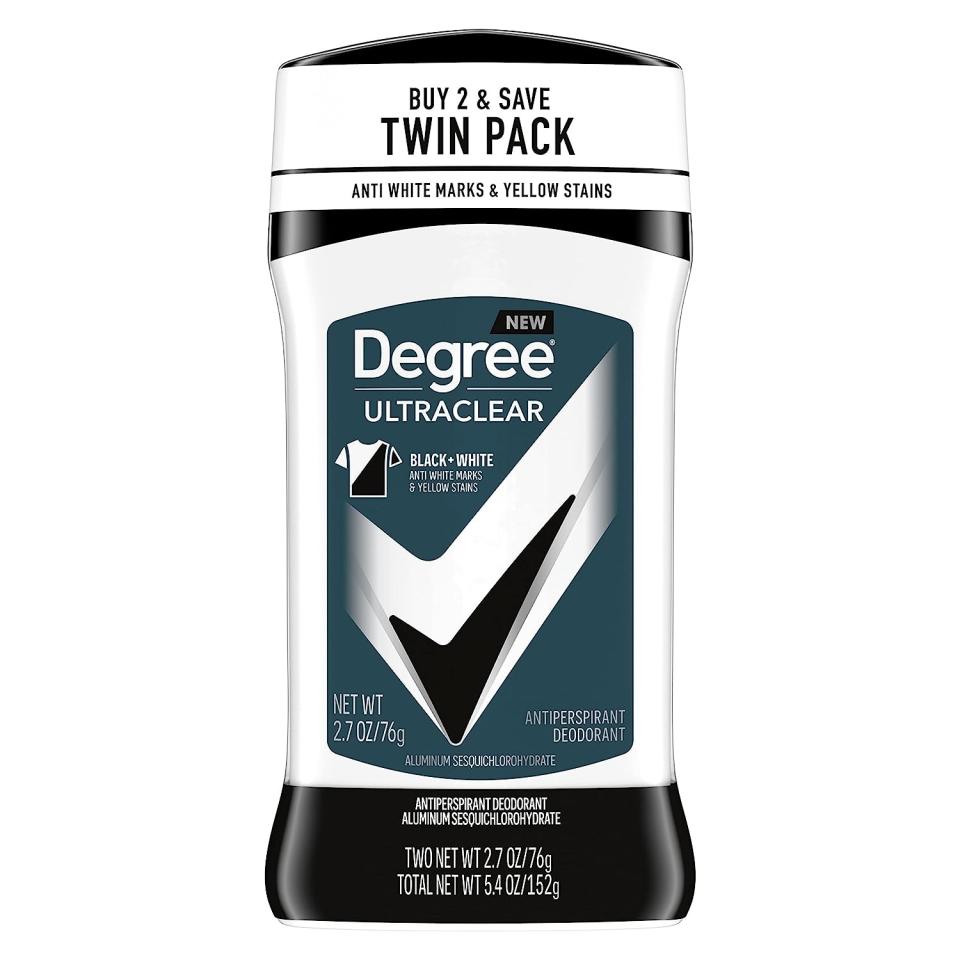
BEST FOR CLOTHES
Degree Men UltraClear Antiperspirant Deodorant
Buy Now On Amazon
Buy Now at target
Key Ingredient: Aluminum sesquichlorohydrate (9.6%)
How It Works: By using the sensitivity-approved ingredient aluminum sesquichlorohydrate, Degree’s UltraClear is great for all skin types (for up to 3 days, no less), and also has less impact on fabrics. The ingredient is effective at stopping both sweat and odor without leaving white streaks.
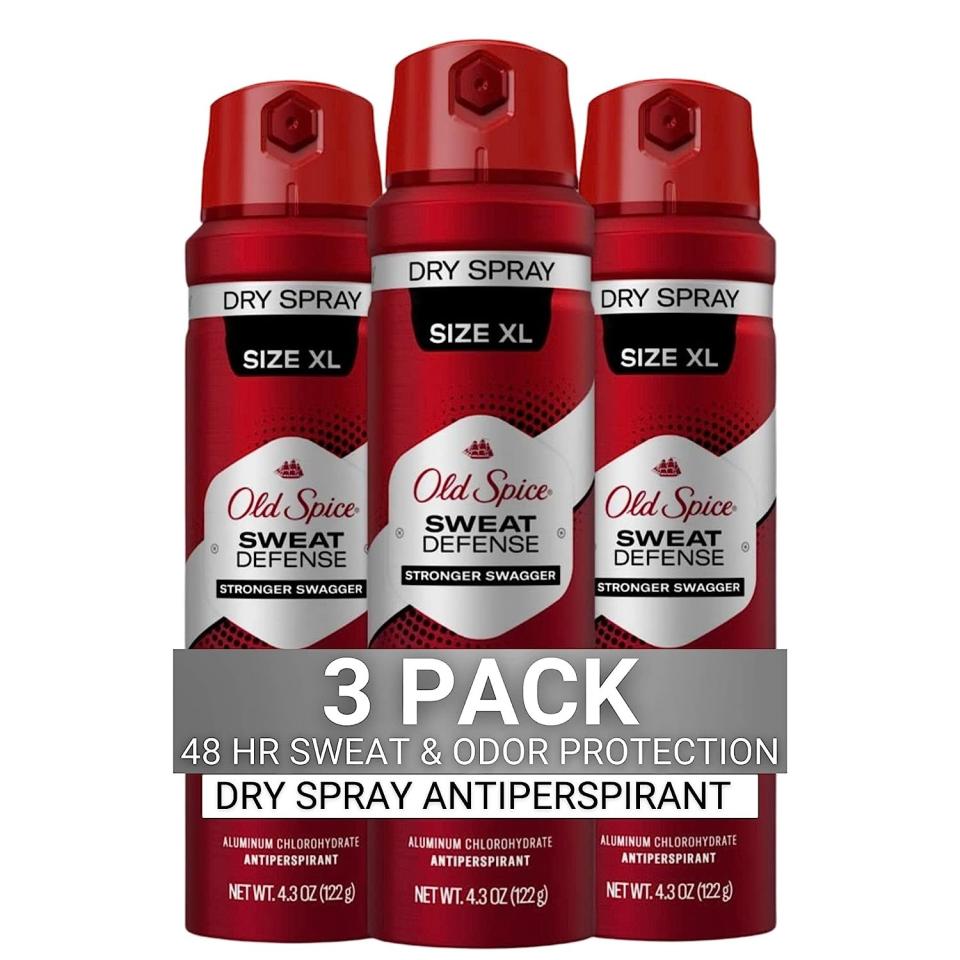
BEST SPRAY
Old Spice Dry Spray Antiperspirant
Buy Now On Amazon
Buy Now at target
Key Ingredient: Aluminum chlorohydrate (24.5%)
How It Works: This 48-hour antiperspirant spray contains fabric-friendly aluminum chlorohydrate, one of the most tolerable aluminums available. There’s also something oddly satisfying about blasting one’s pits with an aerosol can, evocative of a dousing fire hose, as opposed to the slow burn of applying a roll-on. Maybe it’s the refreshing scent that fills the air, especially when it’s from Old Spice, who never fails in the olfactive department.
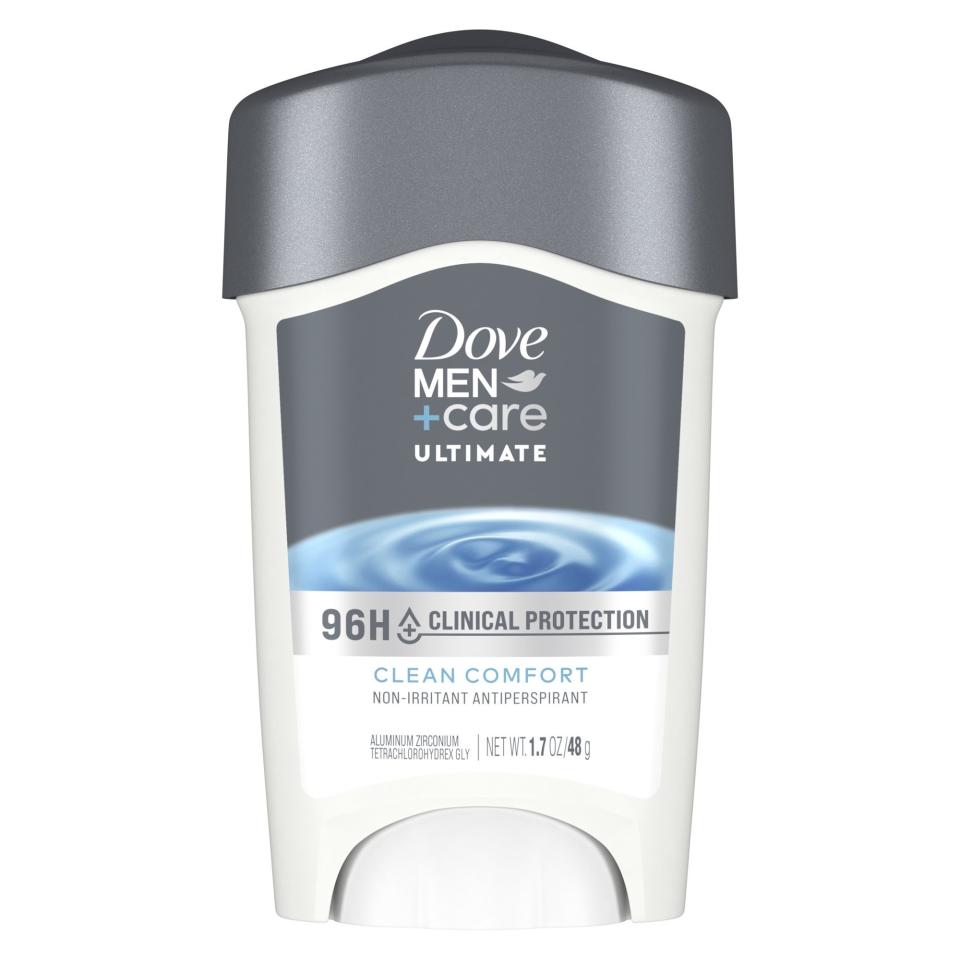
BEST FOR LONGEVITY
Dove Men+Care 96-Hour Antiperspirant
Buy Now at walmart
Buy Now at target
Key Ingredient: Aluminum zirconium tetrachlorohydrex GLY (20%)
How It Works: A common ingredient in formulas that treat hyperhidrosis, aluminum zirconium tetrachlorohydrex is among the most effective sweat stoppers, and this 20% formula lasts as long as 4 days on most wearers. Plus, Dove deploys its signature 25% moisturizing formula in each stick, so that skin doesn’t dry out or get irritated.
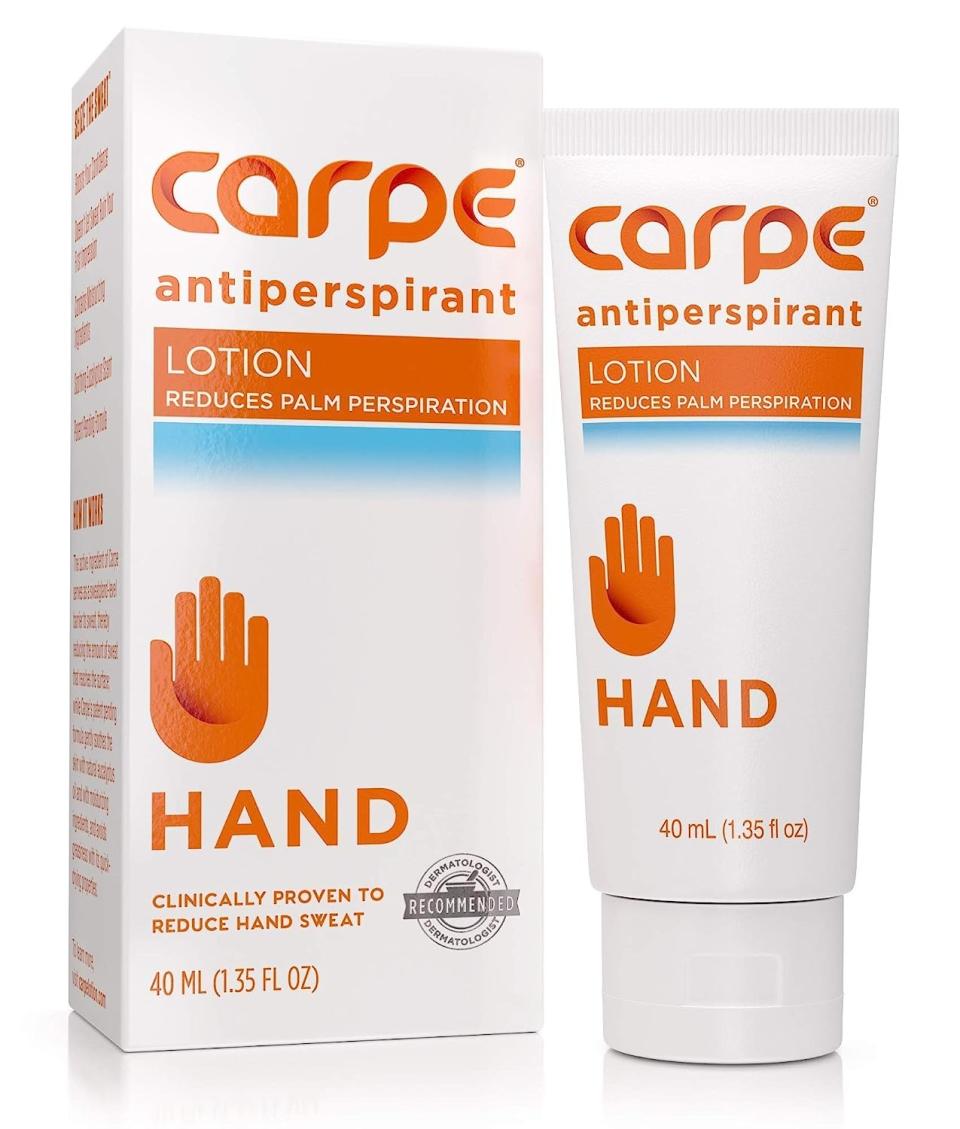
BEST FOR SWEATY HANDS AND FEET
Carpe Antiperspirant Hand and Foot Lotion
Buy Now On Amazon
Key Ingredient: Aluminum sesquichlorohydrate (15%)
How It Works: Target your palms and soles with a pea-size of each respective lotion. They use sensitive-minded aluminum sesquichlorohydrate to counter both moisture and odor, while additional ingredients work to keep skin smooth (citric acid), nourished (glycerin), and tingly fresh (eucalyptus oil).

BEST SALT-CRYSTAL DEODORANT (ANTIPERSPIRANT BOOSTER)
Crystal Mineral Salt Deodorant Stick
Buy Now On Amazon
Key Ingredient: Potassium alum (mineral salts)
How It Works: As Dr. Soleiman stated, mineral-salt deodorants are a time-tested, more natural way of enjoying the moisture-slowing benefits without any pore-clogging aluminum. Even though “natural” antiperspirants are a bit of an oxymoron, when used opposite your existing anti-sweat treatments, this Crystal deodorant can kill the odorous bacteria (and those produced by the first signs of sweat). That means, if you choose to pair it with an antiperspirant, you can apply the aluminum product less often than before.
FAQ’s
1. Is antiperspirant also deodorant?
No. Antiperspirant targets sweat while deodorant targets moisture. It is true that antiperspirants can prevent odor from moisture accumulation, but the primary cause of body odor is bacterial accumulation.
2. Can Botox prevent underarm sweating?
Yes, when injected in the armpits, Botox can halt the contraction of sweat glands in the area. As such, it is an effective treatment for individuals who suffer from hyperhidrosis.
3. What are the best antiperspirant alternatives?
Botox: Botox is an effective treatment for excessive sweating (hyperhydrosis) “It works by stopping the contraction of the sweat gland muscles so sweat isn’t pumped out,” says Soleiman. “Botox has a great safety profile and when used in proper amounts, the effect can last up to six months.
Alternate topicals: While aluminum is the true winner in stopping sweat, other topical ingredients can prevent moisture accumulation and gnarly pit stains. Corn starch, tapioca starch, arrowroot powder, kaolin clay, and baking soda are all common examples of ingredients that can absorb moisture without clogging pores. Another option is salt crystal deodorants. “They kill the bacteria that cause some of the foul smell in sweating,” says Soleiman. “I recommend it monthly as an adjunct to any other solution because even a small amount of sweating can sometimes smell terrible.”
Morpheus 8 and Miradry: These clinical treatments work by burning the sweat glands with radiofrequency (Morpheus 8) and thermal energy (Miradry), says Soleiman.
4. Can I apply antiperspirants to my whole body?
You can do whatever you want. We’re not the boss of you. Many people who experience hyperhidrosis will use aluminum-packed creams on their hands and feet in addition to their armpits. That said, there aren’t many studies out there researching the effect of aluminum when applied anywhere but the armpits. While existing studies suggest it isn’t a huge risk, maybe opt for a tapioca starch powder or cream in the netherregions, a mattifying moisturizer for your face, and some breathable fabric all around?
5. Why does antiperspirant stain my clothes?
The aluminum salts that transfer from your skin to the fabric are what leave a stain on the clothes. Try applying the antiperspirant before bed (to fully clean, dry skin), and you’ll experience less transfer the following day when you put on your clothes. Or just wear basketball jerseys, exclusively. No sleeves = no pit stains.
More Top Deals from SPY
Best of SPY